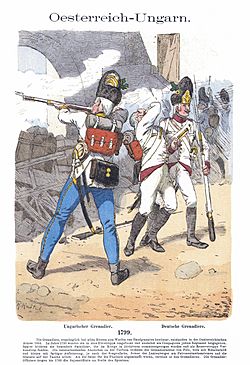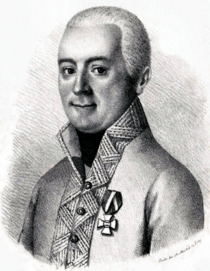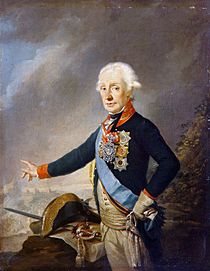First Battle of Marengo (1799) facts for kids
Quick facts for kids First Battle of Marengo (1799) |
|||||||||
|---|---|---|---|---|---|---|---|---|---|
| Part of the War of the Second Coalition | |||||||||
 Habsburg Austrian grenadiers fought at First Marengo. |
|||||||||
|
|||||||||
| Belligerents | |||||||||
|
|||||||||
| Commanders and leaders | |||||||||
| Strength | |||||||||
| 5,000–8,000 | 11,000–16,500 | ||||||||
| Casualties and losses | |||||||||
| 500 to 1,500 | 150 to 720 | ||||||||
The First Battle of Marengo, also called the Battle of San Giuliano, happened on May 16, 1799. It was a fight during the War of the Second Coalition, a big conflict in Europe. In this battle, French soldiers, led by General Jean Victor Marie Moreau, tried to scout out the positions of a larger army. This larger army was made up of soldiers from Austria and Russia, commanded by Field Marshal Alexander Suvorov.
At first, the French army did well, pushing their enemies back. But soon, many more Austrian and Russian soldiers arrived. This forced the French to retreat to the city of Alessandria. The battle took place near Spinetta Marengo in northwest Italy.
Contents
Why the Battle Happened: The Background
The year 1799 saw a lot of fighting in Italy. The Austrian army, led by General Paul Kray, was fighting the French Army of Italy. The French had lost some important battles, like the Battle of Magnano on April 5. This meant they had to leave parts of northern Italy.
The French army was getting smaller and losing morale. Then, a famous Russian general, Alexander Suvorov, arrived with his soldiers. He took command of both the Austrian and Russian armies.
The French commander, General Barthélemy Louis Joseph Schérer, resigned. General Jean Victor Marie Moreau took over the French army on April 26, 1799. The very next day, Suvorov attacked and won the Battle of Cassano. This forced Moreau and his troops to retreat west.
Moreau gathered about 20,000 soldiers near the fortress city of Alessandria. Meanwhile, another French army, the Army of Naples, was moving north from southern Italy. Both Moreau and Suvorov were watching this army closely.
Suvorov wanted to move his army across the Po River to attack Turin. But Moreau decided to send his troops on a strong scouting mission towards Tortona on May 16. This was to find out what Suvorov's army was doing.
The Battle of Marengo Begins
Before the main battle, Cossack soldiers (Russian cavalry) had already cleared the French from the village of Marengo. The Austrians were gathered east of San Giuliano, and the Russian advance guard was further away.
On May 16, General Moreau sent General Claude Perrin Victor with about 7,500 French troops to scout the area. This kind of mission is called a "reconnaissance in force." It means sending a strong group to find out where the enemy is and how strong they are.
The French crossed the Bormida River. They split into two groups, one led by General Louis Léonard Antoine de Colli-Ricci and the other by General Gaspard Amédée Gardanne. They quickly pushed back the Cossacks and other enemy outposts from Marengo and nearby villages.
General Franz Joseph, Marquis de Lusignan led the Austrian soldiers who were there. Soon, General Pyotr Bagration arrived with his Russian troops to help. The two sides lined up for battle. The French sang their national anthem, the Marseillaise, while the Austrian bands played music.
The fighting was tough. The French kept up a steady fire. The Austrians bore the main attack and were pushed back. Bagration's Russian troops also helped fight off the first French attack. But around noon, the Allied (Austrian and Russian) forces started to retreat.
Later, around 4:00 PM, General Moreau realized that the enemy had many more soldiers than he did. He gave the order for his troops to retreat. The French managed to pull back in an organized way. They defended Marengo strongly, using the buildings and nearby streams to their advantage.
By 5:00 PM, the French left Marengo. They crossed the Bormida River and took down their bridge by 6:30 PM. General Suvorov arrived on the battlefield and was upset that the French had been allowed to escape. But by then, it was too late to stop them.
What Happened After the Battle
The battle was a victory for the Allied forces (Austria and Russia). The French lost between 500 and 1,500 soldiers. The Allies had fewer losses, around 150 to 720 soldiers.
Moreau's scouting mission didn't quite work as planned. He had hoped to find out Suvorov's next move. The battle on May 16 convinced Moreau that he needed to leave the flat plains of Italy. He decided to move his army into the mountains, the Ligurian Alps.
Moreau sent some of his troops, led by General Victor, to join another French general in Genoa. These soldiers had to fight their way through local rebels who were against the French. They reached Genoa by May 22.
Moreau, with his remaining soldiers, tried to cross the mountains. But rebels blocked his way. So, he moved west and then circled south of Turin. He managed to get some supplies across the mountains. However, he couldn't get a lot of cannons that were in the Turin arsenal.
With about 10,000 men, Moreau marched south through the mountains. His troops finally reached Loano on June 6. From there, they shipped their cannons to Genoa. Moreau's long and difficult march was compared by one historian to the movements of "a frightened hen."
Meanwhile, Suvorov's army crossed to the north bank of the Po River. They reached Chivasso by May 25, 1799. The Allied army pushed the French out of Turin and captured many heavy cannons. These weapons would later help the Austrians capture French forts like Alessandria and Tortona.
About a month after this battle, another smaller fight, the Second Battle of Marengo, happened in the same area on June 20.
Armies in the Battle
French Forces: Jean Victor Marie Moreau's Army
| Divisions | Brigades | Units | Unit Commanders |
|---|---|---|---|
| Division Victor General Claude Perrin Victor |
Colonel Antoine-Alexandre Rousseaux |
|
Antoine-Alexandre Rousseaux |
| General Luigi Leonardo Colli-Ricci |
|
Dominique Honoré Antoine Vedel | |
|
|
Jean Claude Moreau | ||
|
|
Jules-Alexander Boutrouë | ||
|
|
Joseph Denis Picard | ||
| General Gaspard Amédée Gardanne |
|
Louis-Stanislaus-Xavier Soyez | |
|
|
- | ||
|
|
- | ||
|
|
- | ||
|
|
- | ||
|
|
Louis Lepic | ||
| Colonel Louis Gareau |
|
__ Lucotte | |
|
|
__ Dupellin |
Austro-Russian Forces: Alexander Suvorov's Army
| Division | Brigades | Strength | Units | Strength |
|---|---|---|---|---|
| Advance Guard Division General Pyotr Bagration |
None | 4,161 |
|
624 |
|
|
698 | |||
|
|
627 | |||
|
|
501 | |||
|
|
453 | |||
|
|
435 | |||
|
|
414 | |||
|
|
409 | |||
| Division Lusignan General Franz Joseph, Marquis de Lusignan |
Colonel Franz Xavier Weber von Treuenfeld |
3,398 |
|
618 |
|
|
457 | |||
|
|
582 | |||
|
|
1,741 | |||
| General Hannibal Sommariva |
1,976 |
|
520 | |
|
|
620 | |||
|
|
836 | |||
| Division Kaim General Konrad Valentin von Kaim |
General Franz Xavier von Auersperg |
1,767 |
|
740 |
|
|
858 | |||
|
|
169 | |||
| General Anton Ferdinand Mittrowsky |
3,306 |
|
742 | |
|
|
1,718 | |||
|
|
846 | |||
| Advance Guard Only its outposts were engaged. |
General Andreas Karaczay |
5,271 |
|
2,695 |
|
|
1,641 | |||
|
|
935 |
More Battles and Information



